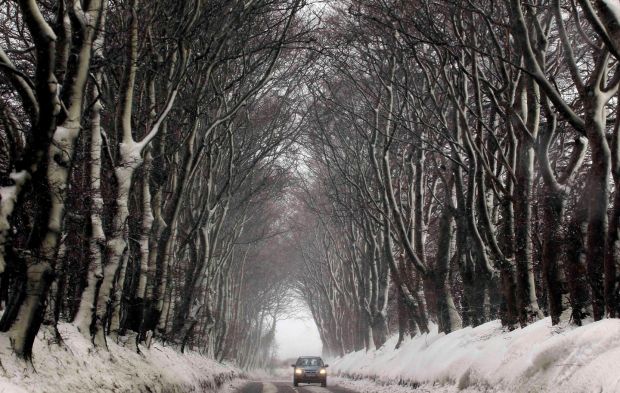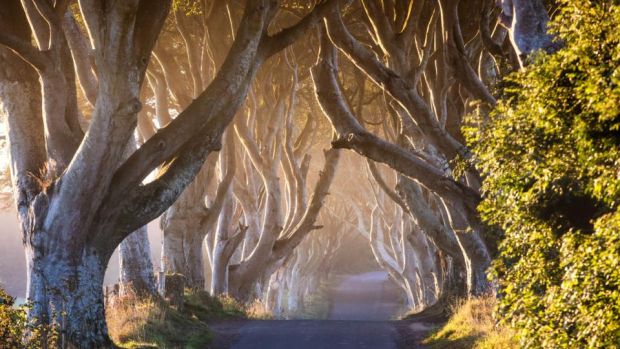A simple pleasure of driving on Irish backroads is coming across one that is tunnelled with branches of overarching trees. In their giddy spring finery they knit together, a riot of subtle browns, auburns and ochres forming part of a multicoloured leaf canopy.
On many roads, a subaqueous light seeps through branches showing glimpses of sky while the intertwining and entangling fan-vaulting trees produces an ethereal quality. The writer Paul Theroux describes such sunny country roads with dappled light as having “a sense of purification”.
Ireland is richly endowed with many of these minor routes – one example is the Bregagh road at Stranocum in north Antrim. For an unprepossessing single-track country lane lined with a few twisted old beech trees, it has – disproportionate to its half-kilometre length – attracted the attention of tens of thousands of visitors. Known as the Dark Hedges, it has been recast as Kingsroad in the epic fantasy TV series Game of Thrones, and with its foreboding atmosphere, has become a celebrity road of Instagrammable fame.
In the early 1770s, when the Stuart family built their house called Gracehill, they lined the avenue with two rows of 150 beeches to impress visitors. The house was named after James Stuart’s wife, Grace Lynd, and on Taylor and Skinner’s Maps of the Roads of Ireland in 1778 it is clearly identified.
The owner then could scarcely have guessed that the narrow laneway would become a 21st-century organic tree alley with a preservation order in an area that is so crowded it is now closed to all but local traffic.
Over many decades the road was well-known to courting couples, despite tales of its reputation for a ghostly apparition. A local story features a grey lady gliding along it, sashaying between the trees, vanishing at the last one. Some believe she is the ghost of a maid from the house who died in mysterious circumstances, while others say she is a lost spirit from a deserted graveyard thought to lie hidden in nearby fields.

During an average week in the busy season, several thousand “location tourists” visit the site to capture photogenic images of the gnarled trees.
When the dust settles and the blood has finally dried, some are wondering if the serene Dark Hedges will return to a zone free of ‘overtourism’
It is particularly beguiling on a misty evening at dusk, and apart from photographers has inspired artists, composers and writers.
When two of the beeches came down in storm Gertrude in 2016, the wood from the fallen trees was transformed into 10 ornately-carved doors, each depicting moments inspired by the series. The “Doors of Thrones” now hang in pubs and hotels near filming locations and are a tourist trail.
The north has become legendary GoT territory, and with a sense of enterprising exploitation, more than 50 local firms (at a conservative estimate) have developed a raft of commercial connections to it. Tour companies and coach operators vie for business bringing many nationalities to the Dark Hedges and some of the other 25 sites.

Coastlines, mountains, beaches, harbours, caves, lakes and forests have all provided a dramatic backdrop for the show. A Hedges Hotel and an Experience Centre have sprung up faster than a beech tree, and along with craft shops, are cashing in on the spin-off bonanza of the blockbusting series.
You can partake of a GoT-inspired banquet or afternoon tea with Winterfell jaffa cakes, Kingslayer cupcakes and Sansa Stark’s lemon cakes, or be locked in a Thrones escape room. Goldsmiths have designed jewellery showcasing necklaces, earrings and cufflinks connected to the programme, and the merchandising inevitably includes fridge magnets, mugs, badges, key-rings, coasters and posters.
Not to be outdone, the Ulster Museum has jumped on the bandwagon, producing a Thrones tapestry, an 80m-long medieval-style wall hanging primarily made from Irish linen sourced from one of the last surviving mills at Banbridge. Episode by episode, the story graphically unfolds with an array of images from golden crowns and frozen kings to swordfights and executions. Delicately hand-embroidered and carefully embellished – it took more than 1,000 hours of work – the tapestry reflects the heritage of textile manufacture.

In the autumn it will transfer to Bayeux, where it will take its place alongside one of the world’s most famous tapestries which also recounts an epic battle – this one in 1066.
After 10 years, the eighth and concluding season has been completed and its screening coincides with an exhibition where “Throners” will have the opportunity to “step inside the mythical lands of Westeros and Essos”. When the dust settles and the blood has finally dried, some are wondering if the serene Dark Hedges will return to a zone free of “overtourism”.
Since it first started, the show has become one of the most talked about on social media in the United States. Estimates of its spending on goods and services suggest it has generated a staggering £210 million for the northern economy. Who says money doesn’t grow on trees?
The Game of Thrones exhibition runs at the Titanic Exhibition Centre, Belfast, from April 11th to September 1st, 2019. gameofthronesexhibition.co.uk



















![[Book Review] The Blade Itself (The First Law Trilogy) by Joe Abercrombie](https://bendthekneegot.com/wp-content/uploads/2018/01/1516047103_maxresdefault-218x150.jpg)

















